In her 2024 book, A Year Full of Pots: Container Flowers for All Seasons, gardener extraordinaire and author Sarah Raven celebrates the nearly 400 containers at her Perch Hill home in East Sussex. Sara describes pots in the garden as “the bubbles in the glass of champagne, the cherries on the cake, the grace notes of a composition.” Beautifully photographed by Jonathan Buckley, the title shares month-by-month tips and seasonal focus on specific plants for your containers. The following excerpt dives into a garden favorite, petunias—along with their cousins, calabrachoas (million bells) and petchoas.

When it comes to petunias, the richer and more intense the colour, the better in my view. That’s why the silk-velvet-petalled Petunia ‘Tidal Wave Red Velour’ is my favourite. Everything about it is strong: its colour, its texture and the way it grows. It germinates quickly and easily from seed (or you can propagate from cuttings taken in autumn) and then it grows fast once pricked out, romping away as soon as it’s planted into its final pot. Within a couple of weeks, you’ll have crushed-velvet swags growing out and over the edge of your pots. And it keeps going with minimal TLC. We’ll tidy it up and deadhead it once every couple of weeks, and it’s included in our three-times-a-week watering regime, but that’s it. This makes it the perfect Spiller in a large pot mix. In fact, it’s such a romping grower, if you provide it with a climbing frame and tie a few of its shoots to go up, not trail down, it will reach well over a metre and become a fantastic Pillar plant. We started to use this as a cut flower last summer: with stem ends seared for a few seconds in just-boiled water, it lasted nearly two weeks in a vase.
If pale colours are more your thing, there’s another petunia in the brilliant Tidal Wave series called ‘Tidal Wave Silver’ – we grow this in our cool area around the lawn. It opens white with delicate purple veining, which then washes over the trumpet flowers to turn them soft mauve. This is as densely covered in flower as its red relation, but one step down in terms of vigorous growth.
It seems that the paler petunias (which are more closely related to the species P. axillaris) often have scent. ‘Tidal Wave Silver’ doesn’t, but the double ‘Tumbelina Priscilla’ has a good perfume that, rather like the winter-flowering shrubs Sarcococca confusa or wintersweet (Chimonanthus praecox), catches you almost unawares as you walk past. We have trialed, but rejected, ‘Lavender Sky’ (it looks like it’s spent the night in the rain) and ‘Lightning Sky’ (too overworked and fussy). And there are a few we’ve trialed which are just too bright.
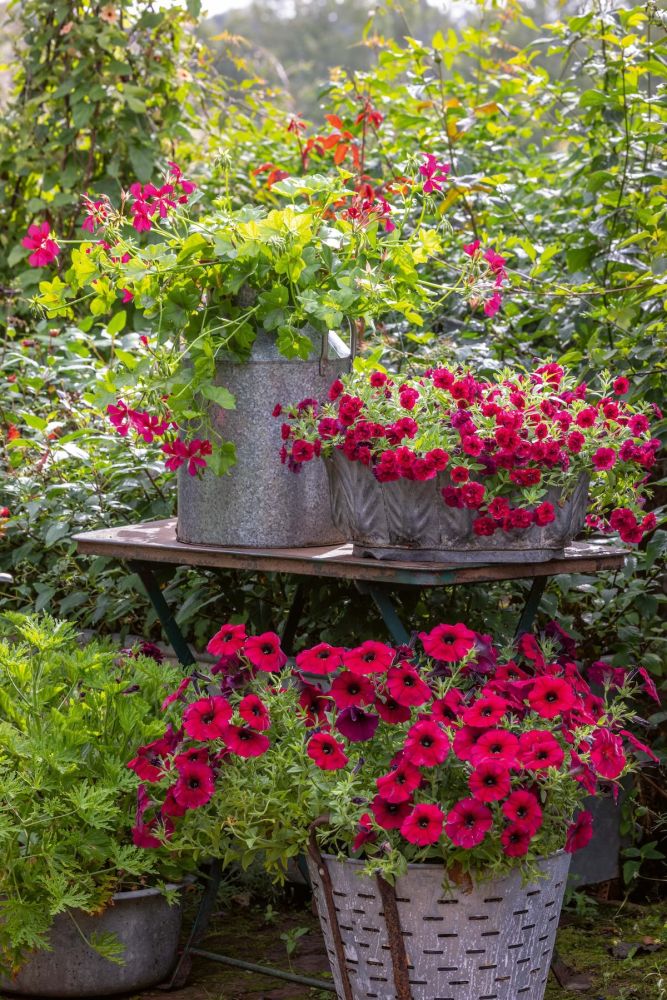
Even in our much-loved Tidal Wave series, I find the purple variety too synthetic, beaming out like neon from a hundred feet away.
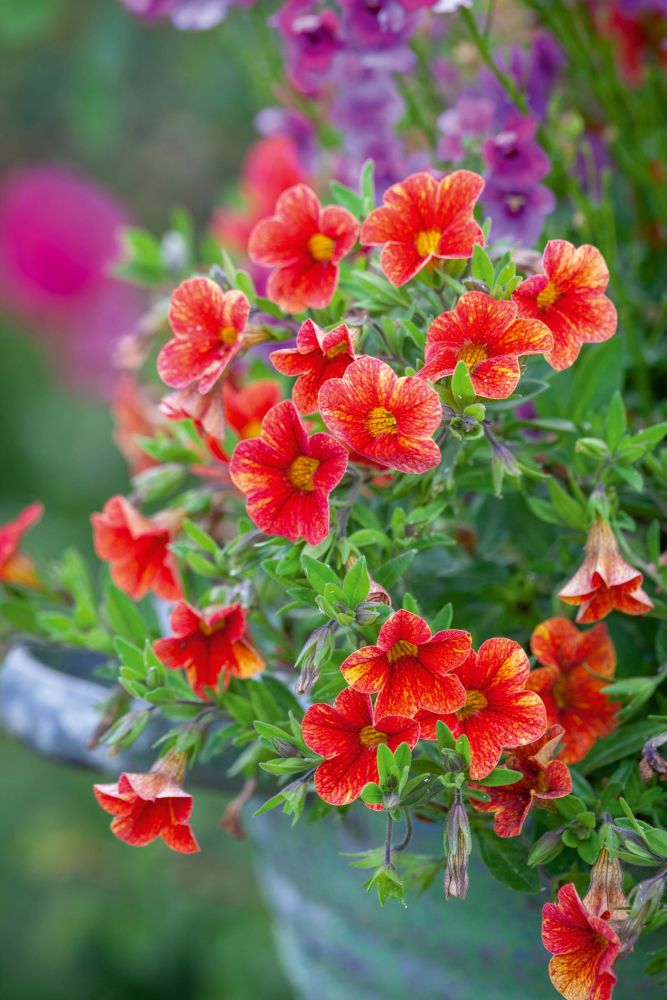
Calibrachoas
As well as petunias, we mustn’t forget the calibrachoas, whose flowers are usually about a third the size of petunias and have even more of them. Another difference is their leaves are not sticky (like petunias) and their flowers have a much milder scent. Calibrachoas are commonly known as million bells or superbells and they really are the epitome of plush curtain tassels, or that great word passementerie – fussy but lovely ornamental trims. Their overall habit is more compact and petite than petunias, but they’re still strong growers with a hugely long-flowering season. We love them here for small table centre pots. They can be grown in part shade, but the number of flowers you get is related to the amount of sun exposure. They don’t need deadheading, but we do pick them over and, occasionally, cut back stems to encourage branching and fresh growth. They are quite tolerant of the forgetful gardener, but when their leaves start to wilt, they need a good watering.
Petchoas
Then there’s the petchoa – a newish hybrid between the petunia and calibrachoa. For me, they are the new stars. Brilliant performers and quite weather tolerant, they are very flowery (like calibrachoas) with larger flowers (like petunias). We grow and love several of these. I’m really fond of the rusty ‘BeautiCal Cinnamon’ and pale custard-coloured ‘BeautiCal French Vanilla’. These seem classy and sophisticated, with an overall sepia, vintage look and feel. They also cut brilliantly.
In terms of planting, it’s best to keep the brights and the pales in separate pots and areas. Though, really, we’d rarely put two petunias, petchoas or calibrachoas in one pot together anyway. Even in two different but complementary colours, they’d merge and look too samey.
It’s worth knowing that even the single petunias are not a great source of food for pollinators, although the hummingbird hawkmoths feed on the singles as they can reach into the throats.
Best of the petunias and calibrachoas
As one of the world’s most popular bedding plants, there’s continuous breeding of petunias with new subgroups appearing all the time. Here are our favourites, which have stood the test of time at Perch Hill, including the petchoas and surfinias.
Rich and Bright
This lot features saturated bright shades and intense, rich ones too.
Petunias
1 Petunia ‘Black Velvet’
I am often tempted by black flowers, particularly when they’re velvety, but you have to be careful that they don’t create an undefined black mass. You want them to stand out, so have something sharp and bright as a backdrop. ‘Black Velvet’ is marvellous if combined with lots of bright or acid-green plants.

2 P. Tidal Wave series
‘Tidal Wave Purple’ is almost luminously bright and if you want something super showy, this will do the job. It’s hugely flowery but not really for me in terms of colour. ‘Tidal Wave Red Velour’ is first class in all ways. You’ll see it in endless container collections here and on its own. It climbs as well as trails. A stellar plant.
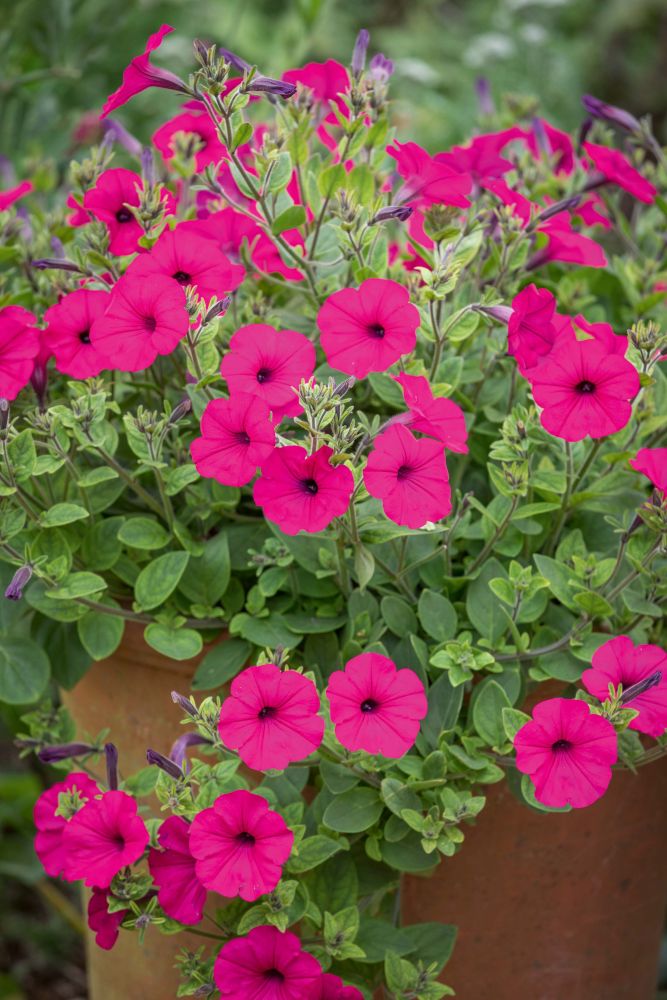
3 × Petchoa BeautiCal series
‘BeautiCal Bordeaux’ is a classy deep red, one shade brighter than ‘Tidal Wave Red Velour’, but not as prolific. ‘BeautiCal Cinnamon’ is a sophisticated colour which moves from cinnamon to crimson, sometimes with a wash of gold. You’ll either love it or hate it. It’s quite a difficult shade to combine with other plants, but it holds its own in a pot. I’ve grown it to great effect in large terracotta long toms running down the side of the path in the Perennial Cutting Garden.
Calibrachoas
4 Calibrachoa Can-can series
‘Orange Punch’ genuinely looks like a fruity punch in a clear glass bowl, perhaps an orange juice mixed with Campari. A good and long performer. ‘Black Cherry’ is a lovely single and almost black. Billowing out from a large, low table centre pot, this looks like a swag of velvet. And ‘Double Can-Can Wine Red’ is one of my favourites for its mahogany richness and length of flowering. We include this in quite a few of our summer and autumn pot collections.
5 C. Million Bells series
There are quite a few orange calibrachoas and we’ve grown ‘Million Bells Crackling Fire’ for more than a decade now – it has stood the test of time. ‘Million Bells Red’ is a deep ruby shade with single flowers (‘Cabaret Red’, in the Cabaret series, is a good substitute). ‘Million Bells Terracotta’ is one we’ve grown for ages and it looks fantastic with nemesias.
6 C. Superbells series
These ones are all doubles, which means they don’t have forage for pollinators because their nectaries have been bred to be secondary petaloids, so they are infertile. It does mean each flower lasts longer than the singles, making them low- maintenance, with minimal deadheading needed. ‘Double Ruby’ is a truly rich red and is also quick growing, strong and healthy. ‘Doublette Love Swept’ is a bright yet nicely fading peach-pink.
Soft and Pale
These palettes include plenty of white and soft colours.
Petunias
1 Petunia × atkinsiana
Surfinia Group
We love to grow these trailing petunias. We’re not looking for them to hang down the edge of a pot, but more to spread out their shoots from a shallow tabletop pot and send soft-textured saucer-sized flowers in all directions. ‘Blue Vein’ is lovely for this. It has deep purple hearts and veins that elegantly break up the white petal base. ‘White’ has a green eye and soft green veining over the petals.
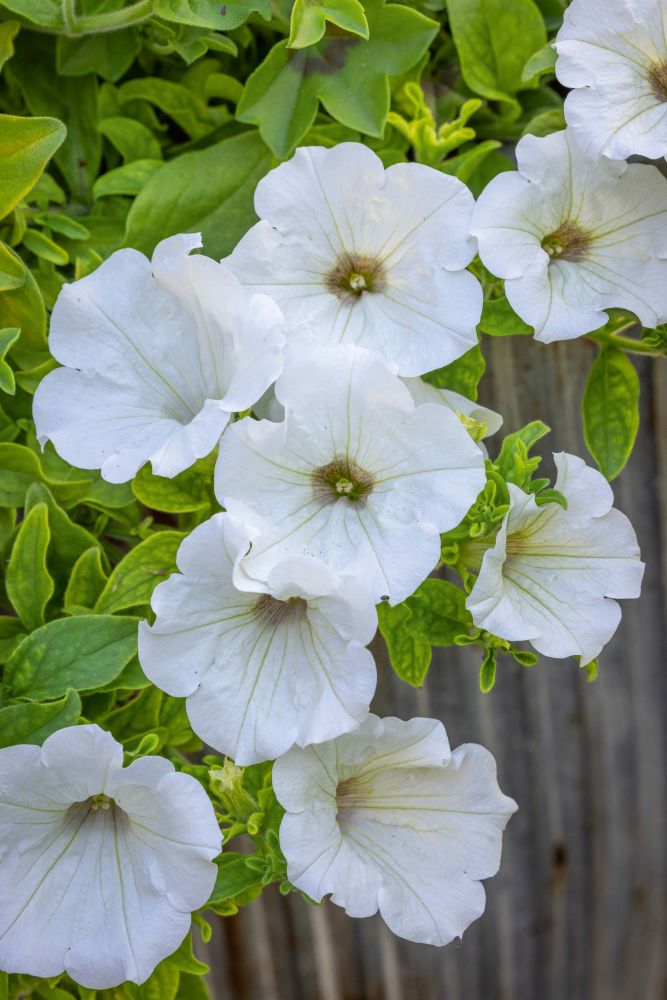
2 P. axillaris
A species petunia that is easy to grow from seed. It has a wonderful perfume and the petunia’s classic, very sticky buds and leaves.
3 P. ‘Sophistica Lime Green’
I’d like this to be a touch more acid-green, but it has its place in white pot mixes where it brings freshness and contrast.
4 P. ‘Supertunia Latte’
In the Supertunia series, this has a wonderful creamy-white base with chocolate markings. A long and late flowerer.
5 P. Tidal Wave series
‘Tidal Wave Silver’ is a massive favourite here for being an excellent, reliable flowerer.
6 P. Tumbelina series
This series features small-flowered varieties with blooms halfway between petunias and calibrachoas. The mauve ‘Priscilla’ has a stock-like scent.
7 × Petchoa BeautiCal series
‘BeautiCal French Vanilla’ is in the same series as ‘BeautiCal Cinnamon’ and is similarly sophisticated in a subtle colour, which I love. This reminds me of crème brûlée: soft, creamy yellow with a burnt sugar top (in fact, a heart in this case).
Calibrachoas
8 C. Can-can series
‘Appleblossom’ is a pretty, single, white flower form with pink throat and markings. A good performer offering a long season. ‘Double Apricot’ is a rather wonderful mix of muted apricot moving to peach, but its double flowers (like crumpled tissue paper) also have deep red hearts and markings. Very pretty. For the best sort of smoky, vintage mauve you can’t beat ‘Double Dark Lavender’. The colours fade as the flowers age to give a good mix of tones. And ‘Double White Improved’ is completely covered in snowball blooms, almost like a bacopa in its floweriness all summer and autumn.
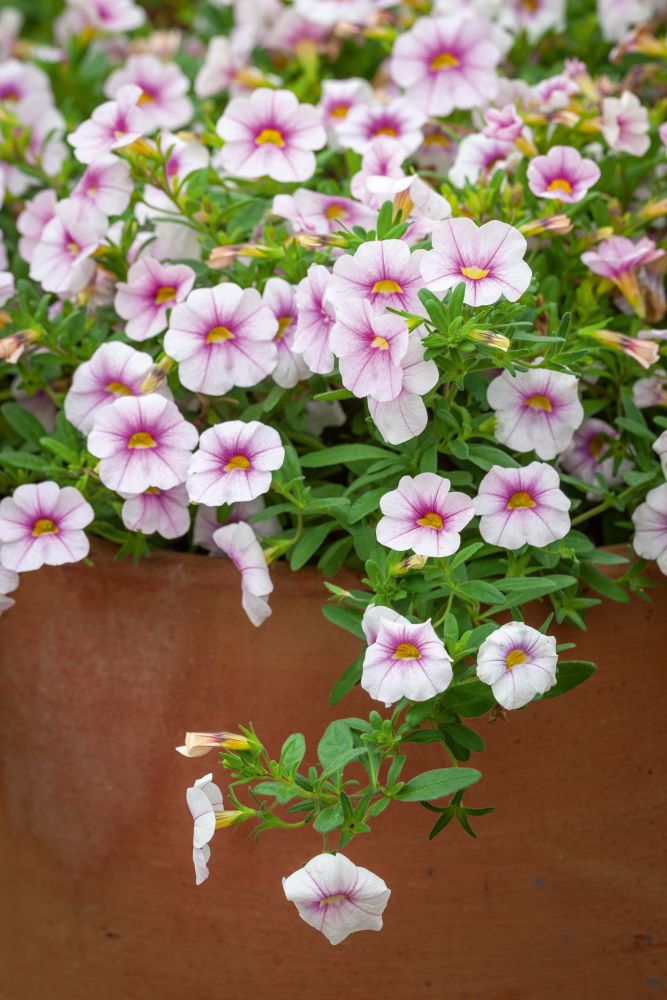
Excerpted from A Year Full of Pots: Container Flowers for All Seasons by Sarah Raven, with photographs by Jonathan Buckley, published by Bloomsbury Publishing. Copyright © 2024 by Sarah Raven’s Cutting Garden Limited. All rights reserved.
Buy the book to find more tips and container arrangements!

